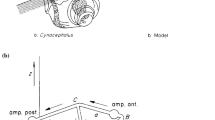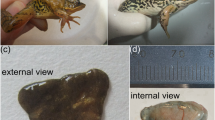Summary
The spiracular organ is a lateral line derived receptor associated with the first gill cleft (spiracle). Its functional morphology was studied in the little skate,Raja erinacea, and a shark, the smooth dogfish,Mustelus canis, with light and electron microscopy. The spiracular organ is a tube (skate) or pouch (shark) with a single pore opening into the spiracle. The lumen is lined with patches of sensory hair cells, and filled with a gelatinous cupula. In the little skate, hair cells form synapses with afferents but apparently not with efferent fibers. In both species, the spiracular organs are deformed by flexion of the hyomandibular cartilage at its articulation with the cranium. The hyomandibula is a suspensory element of the jaws; hyomandibular flexion results in jaw protrusion. The little skate spiracular organ is anchored at one end to the cranium and at the other to the hyomandibula so that it is stretched or relaxed during hyomandibular extension and flexion, respectively. InMustelus, the effects of hyomandibular flexion on the spiracular organ are mediated indirectly by the superior post-spiracular ligament which inserts on the distal end of the hyomandibula. Deformation of the dogfish shark cupula during hyomandibular movement was observed. In the little skate, as revealed by transmission electron microscopy, there is a measurable deflection of the hair cell ciliary bundles from spiracular organs fixed with the hyomandibula in the flexed relative to the extended positions. In both species, hyomandibula flexion should result in hair cell depolarization, and sensory afferent excitation, based on the direction of the observed (skate) or expected (shark) deflection of hair cell cilia.
Similar content being viewed by others
References
Allis EW (1902) The lateral sensory canals, the eye-muscles, and the peripheral distribution of certain of the cranial nerves ofMustelus laevis. Q J Microsc Sci 45:87–236
Barry MA, Boord RL (1984) The spiracular organ of sharks and skates: Anatomical evidence indicating a mechanoreceptive role. Science 226:990–992
Barry MA, White R, Bennett MVL (1988) The elasmobranch spiracular organ. II. Physiological studies. J Comp Physiol 163:93–98
Clusin WT, Bennett MVL (1977) Calcium activated conductance in skate electroreceptors: voltage clamp experiments. J Gen Physiol 69:145–182
Flock A (1965) Transducing mechanisms in the lateral line canal organ receptors. Cold Spring Harbor Symp Quant Biol 30:133–145
Hudspeth AJ, Corey DP (1977) Sensitivity, polarity, and conductance change in the response of vertebrate hair cells to controlled mechanical stimuli. Proc Natl Acad Sci 74:2407–2411
Lowenstein O, Roberts TDM (1951) The localization and analysis of the responses to vibration from the isolated elasmobranch labyrinth. A contribution to the problem of the evolution of hearing in vertebrates. J Physiol 114:471–489
Norris HW, Hughes SP (1920) The spiracular sense-organ in elasmobranchs, ganoids and dipnoans. Anat Rec 18:205–209
Oman CM, Frishkopf LS, Goldstein MH (1979) Cupula motion in the semicircular canal of the skate,Raja erinacea. Acta Otolaryngol 87:528–538
Patterson C (1975) The braincase of pholidophorid and leptolepid fishes, with a review of the actinopterygian braincase. Phil Trans R Soc Lond B 269:275–579
Ridewood WG (1896) On the spiracle and associated structures in elasmobranch fishes. Anat Anz 11:425–433
Shotwell SL, Jacobs R, Hudspeth AJ (1981) Directional sensitivity of individual vertebrate hair cells to controlled deflection of their hair bundles. Ann NY Acad Sci 374:1–10
Author information
Authors and Affiliations
Rights and permissions
About this article
Cite this article
Barry, M.A., Hall, D.H. & Bennett, M.V.L. The elasmobranch spiracular organ. J. Comp. Physiol. 163, 85–92 (1988). https://doi.org/10.1007/BF00611999
Accepted:
Issue Date:
DOI: https://doi.org/10.1007/BF00611999




